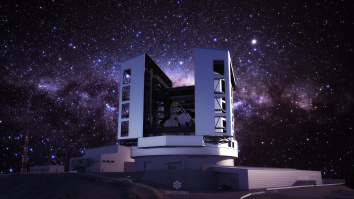Major NSF Grant Accelerates Development for the Giant Magellan Telescope
16 September 2020
The GMTO Corporation has received a $17.5 million grant from the National Science Foundation (NSF) to accelerate the prototyping and testing of some of the most powerful optical and infrared technologies ever engineered. These crucial advancements for the Giant Magellan Telescope (GMT), of which The University of Texas at Austin is a founding partner, will allow astronomers to see farther into space with more detail than any other optical telescope before.
The NSF grant positions the GMT, now under construction at Las Campanas Observatory in Chile, to be one of the first in a new generation of large telescopes. It will be approximately three times the size of any ground-based optical telescope built to date.
“The support from NSF, combined with the resources provided by the GMT founding institutions, including The University of Texas at Austin, brings us one step closer to putting the amazing research capabilities of the GMT in the hands of our faculty, researchers, and students,” said Taft Armandroff, Director of the McDonald Observatory and Vice Chair of the GMTO Board.
The GMT and the Thirty Meter Telescope (TMT) are part of the US Extremely Large Telescope Program (US-ELTP), a joint initiative with NSF’s National Optical-Infrared Astronomy Research Laboratory (NOIRLab) to provide superior observing access to the entire sky as never before. Upon completion of each telescope, US scientists and international partners will be able to take advantage of the program’s two pioneering telescopes to carry out transformational research that answers some of humanity’s most pressing questions, such as are we alone in the universe and where did we come from.
“We are honored to receive our first NSF grant,” said Dr. Robert Shelton, President of GMTO. “It is a giant step toward realizing the GMT’s scientific goals and the profound impact the GMT will have on the future of human knowledge.”
One of the great challenges of engineering revolutionary technologies is constructing them to operate at optimal performance. The Giant Magellan Telescope is designed to have a resolving power 10 times greater than the Hubble Space Telescope — one of the most productive achievements in the history of astronomy. This advancement in image quality is prerequisite for the GMT to fully realize its scientific potential and expand our knowledge of the universe.
“Image quality on any telescope starts with the primary mirror,” said Dr. James Fanson, Project Manager of GMTO. “The Giant Magellan Telescope’s primary mirror comprises seven 8.4-meter mirror segments. To achieve diffraction-limited imaging, we have to be able to phase these primary mirror segments so that they behave as a monolithic mirror. Once phased, we must then correct for Earth’s turbulent atmospheric distortion.”
Phasing involves precisely aligning a telescope’s segmented mirrors and other optical components so that they work in unison to produce crisp images of deep space. Achieving this with seven of the world’s largest mirrors ever built is no easy task. The immense size of the GMT’s primary mirror requires a powerful adaptive optics system to correct for the blurring effects of the Earth’s atmospheric turbulence at kilohertz speeds. In other words, astronomers need to take the subtle “twinkle” out of the stars in order to capture high-resolution data from celestial objects thousands of light-years from our planet.
The NSF grant enables the GMT to build two phasing testbeds that will allow engineers to demonstrate, in a controlled laboratory setting, that its core designs will work to align and phase the telescope’s seven mirror segments with the required precision to achieve diffraction-limited imaging at first light in 2029. It also enables the partial build and testing of a next-generation Adaptive Secondary Mirror (ASM), which is used to perform the primary mirror phasing and atmospheric distortion correction.
“Our seven Adaptive Secondary Mirrors take this technology to the next step,” said Dr. Fanson. “No one has attempted to use seven ASMs before the Giant Magellan Telescope. They are probably the most advanced tech we have on the telescope, and their success is a top priority. We need to test and validate their performance early on in the project.”
Astronomers will use the GMT’s high-fidelity adaptive mirrors and other revolutionary adaptive optics technologies to detect faint biosignatures from distant exoplanets — one of the GMT’s primary scientific goals. This work is part of a larger $23 million joint-award to the Association of Universities for Research in Astronomy (AURA) and the GMT over the next three years. The GMT project is the work of a distinguished international consortium of leading universities and science institutions.
— END —
Media Contact:
Rebecca Johnson, Communications Mgr.
McDonald Observatory
The University of Texas at Austin
512-475-6763








